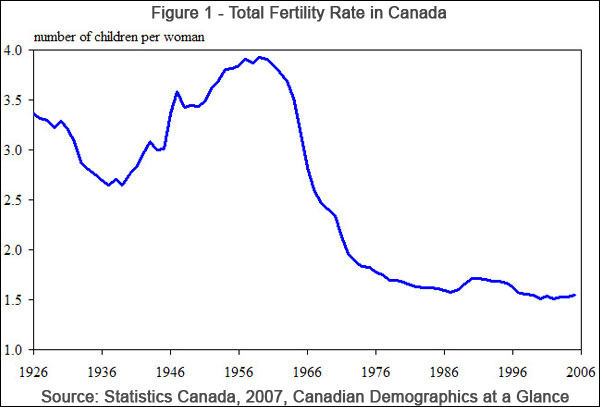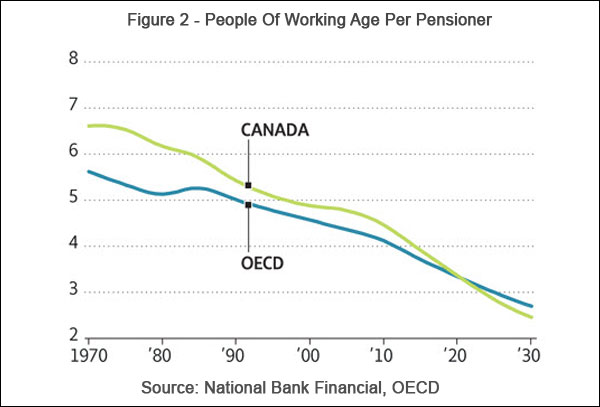Hey Suzuki, Canada is not full and your policies would kill Medicare
David Suzuki, the Canadian environmentalist often touted as having all the answers to halt (alleged) global warming and even to push back (allegedly) rising sea levels, has been caught telling a whopper of a fish story.
On Canada Day, during an interview with a Quebec reporter, he claimed that “Canada is full”, explaining that we have no room for immigrants in this vast country. “Although it’s the second largest country in the world, our useful area has been reduced”, said Suzuki. He then slammed Canadian immigration policy as “disgusting” for trying to maintain our population (and therefore our economy) by bringing immigrants into the country.
On its face, Suzuki’s claim is a lie. Canada is a vast, empty country. Half its population is contained within the relatively tiny geographic areas of Toronto, Montreal, Vancouver, Ottawa, Calgary and Edmonton. A glance at a population density map (below) totally discredits Suzuki’s ludicrous claim. The graph’s legend shows that the only heavy population density exists in those areas which are purple and dark red. The light coloured areas, which cover most of the country, have almost no people or are nearly desolate stretches of forest, farmland, prairies and snow.

Sorry Mr. Suzuki, you’re embarrassingly wrong. Canada is not full, and we have plenty of room for immigrants.
Suzuki’s population-reduction policy would destroy Medicare and Old Age Security
The reduced population that Suzuki so badly craves for Canada, would collapse the country’s social safety nets – namely Medicare, which is already insolvent, and Old Age Security, which is financially unsustainable.
Analysts have warned for years that Medicare and Old Age Security are unsustainable given our demographics. The federal universal health care system was enacted with legislation by Lester B. Pearson in 1966, during a time when each woman had an average of approximately 3 children. See Figure 1.
In 1966, that economic model made more sense. It was based on the birth rate which inevitably dictates the number of workers who end up paying taxes to support social programs, like our publicly funded health care system and OAS. However, the model no longer works because the numbers have changed dramatically.
After the widespread societal acceptance of contraception, followed by the legalization of abortion, Canada’s fertility rate fell steadily and dramatically, to 1.61 children per woman as of 2011. This resulted in a corresponding fall in the ratio of Canadian workers to pensioners which proved economically disastrous. See Figure 2.
The dangerous fall in the birth rate, a consequence of contraception and abortion, has directly decreased the ratio of workers (who pay taxes) per pensioner (who receives taxpayer-funded medicare, OAS, etc). That ratio has been decimated since 1966. In 1970 for example, Canada had almost 6-1/2 workers per pensioner. Today there are barely 4 workers per pensioner. The decline represents a roughly 38% reduction in the number of future workers. By 2030 the ratio is projected to be approximately 2.5 workers per pensioner. This means that our universal health care system (i.e. Medicare) and public retirement income systems are unsustainable. It is a major economic and social crisis which immigration alone cannot solve.
Why is it that immigration alone is inadequate to solve the looming Medicare and public pension crisis? Well, it boils down to age and taxes.
Let’s use an example of a 50 year old immigrant who comes to Canada, starts working immediately, retires at 65 and then dies at 85. This means he will have contributed into OAS and Medicare via payroll tax deductions for 15 years, and then received taxpayer-funded benefits through his retirement for 20 years. By contrast, a young person born in Canada who starts working at age 22, retires at 65 and dies at 85 will have used up taxpayer benefits for the same 20 year period, but contributed through his payroll tax deductions for 43 years. That gap in lifetime tax contribution is the key.
A Simple Solution to a Simple Problem
The reason why we have an impending public pension and Medicare implosion problem is quite simply that Canada has too few workers per pensioner.
Fortunately, the solution is simple too, albeit long term. That is, we have to eliminate abortion, discourage contraception and encourage a higher birth rate. Now, if Saint Suzuki, the alleged answer man, came out with that conclusion, I might become a fan instead of a critic.
I believe that CPP payments are based on your share of contribution of the required premium. So if they paid for only 15 years premium, their CPP cheque will not be very high.
That's why my wife who raised 6 children receives CPP payments of only $150.00 per month.
As far as Mr Suzuki is concerned, I am sure his age is showing by making such an outrageous statement. If Canada is full I am sure he has no problem renting out his houses.
Thanks for the comment. You made me realize that we accidentally used an old version of my blog post which mistakenly referred to CPP instead of Old Age Security. I meant to talk about Old Age Security, not CPP. This blog has been corrected accordingly. OAS is funded by general tax revenues.
Having said that, I don't think we should believe our tax & spend governments (from any political stripe) when they claim the CPP is sustainable. In 1965 when the CPP was established by the Liberals with a contribution tax rate of 1.8%, the gvmt claimed it was sustainable. Years later the gvmt changed its mind and said that was in fact not sustainable, and so, increased the tax rate to 3.6% on employees & employers combined. Then in 1986 they again said it was unsustainable and increased the tax rate to 9.9% as of 2003. Personally, I believe there will be more tax rate increases to try and keep ahead of a collapse. Furthermore, the CPP is only 20% funded with assets at the moment, meaning the rest is an unfunded liability. To me, that doesn't sound conducive to sustainability, especially when you consider that life expectancy is increasing by approximately 2 years every decade.
You also mentioned that the CPP is guaranteed for a 75-year period. I could be mistaken, but I don't think that's precisely what the gvmt has "guaranteed". I think what the gvmt has said is that the current funding formula ensures that the contribution tax rate will not increase for 75 years. But don't we know already that the gvmt makes a lot of promises it never intends to keep?
Although it's a more indirect connection, even the CPP's cashflow problems is affected by our below-replacement level fertility rate, abortion and the consequential effect of these things on the government's pool of tax revenue. If we had a more healthy worker to pensioner ratio, as we used to, there would be a larger tax revenue base available to increase Old Age Security benefits, instead of being so reliant on the CPP.
To summarise: exponential growth is growth based on previous cumulative growth and while it begins slowly it ends with exploding increases. For example, if we were to place a single bacterium in a lab flask (with the following assumptions: the bacteria only requires space as a resource, it will double in number every minute, and it will take one hour to fill the flask), and then figure out how many minutes of 'growth' remain when the flask in only half full, you will discover that only one minute remains. In other words, 59 minutes of the allotted hour were taken to use half the resource but only one minute remains to continue growing. Now, think about this: how many minutes of the resource remain when only 3% of the resource (space) has been used up? Hint: a mere 5 minutes of the 60; the bacteria has 97% of its resource remaining but only 1/12 of the total time until the resource is expended.
Which scenario would you prefer?
This is why Canada is full. If we continue to bang the table for 'growth' we put ourselves in the position of the bacteria who, even if he doubles his resource by finding another entire, empty flask, only provides itself with one final 'doubling' of its population, or one minute of time.
As Professor Bartlett contends, it is a total lack of understanding of how growth works that has put the species in the predicament we're in.
Canada is unique in that it has lots of space and resources, but if we follow Fonseca's logic we simply increase the speed of our eventual demise.
Thanks for your comment. Firstly, the economic point of view is exactly the point. Do you really want to see our social security programs to collapse? Canadians are so proud of their publicly-funded universal health care system. Do you really want to see the health care system collapse? Do you want to see Canadians receive even more sub-standard care than we do already (i.e. doctor shortages, nurse shortages, 8 hour average hospital wait times, months or years on wait lists for certain surgeries or even to see a specialist)? Increasing Canada's worker to pensioner ratio is the only viable solution. Yes, it's long term, but its the only thing that makes our social safety nets sustainable. Marxism/socialism doesn't work. It bankrupts every economy that it takes over.
Secondly, your analogy of Canada's human population growth to bacterium in a flask is seriously flawed. (A) Human beings do not multiply exponentially like bacteria; (B) Our country is not a tiny test tube in a lab. Canada is heavily under-populated even in comparison to the USA; (C) The discredited theory that the world's population would grow exponentially while the world's food supply would grow linear, was promoted in the early 1800's by Robert Malthus. At that time he called for depopulation to head off a world crisis. Malthus could not have been proven more wrong. Thanks to technology, food production (and other resources) grew exponentially, while population growth has been linear. His theory has been fully descredited even though it gave birth to the population alarmism we see embodied in people like Suzuki and Paul Ehrlich. Mr. Ehrlich's 1968 book, Population Bomb, spawned the most egregious human rights violations in the world. It advocated for allowing 'prenatal sex selection' (i.e. sex-selective abortion) and the unfettered right to abortion on the premise that parents would only have children until they conceived a boy, thus reducing population growth. Forced sterilization in India and mandatory one-child policies in China, which led to a surge in female infanticide and the abortion of female babies, are the legacy of these views.
God designed the planet to adequately house a growing human population. God doesn't make mistakes with his designs.
I believe my August 22 10:14am reply addresses your second comment. Canada is not at risk of runnning out of space. Have another look at that population density map too. We're way less populated than even the USA.
Or just nuke a couple of those backward countries like Rome and Spain





at the working tax payer's expense. Any vaccine containing mercury and or aluminum should be banned.
Our immigration policy has brought potential murderers and welfare bums from around the world. Canada should not be a dumping ground. If they won't work - they can do without in their home land.
Stop Monsanto and other chemical suppliers from distributing genetically modified seed in Canada. This junk has been proven harmful to humans and animals. It destroys the bacteria in soil adversely affecting future production.
There is a lot to fix, but we should not stop trying to find solutions.
Art Williams